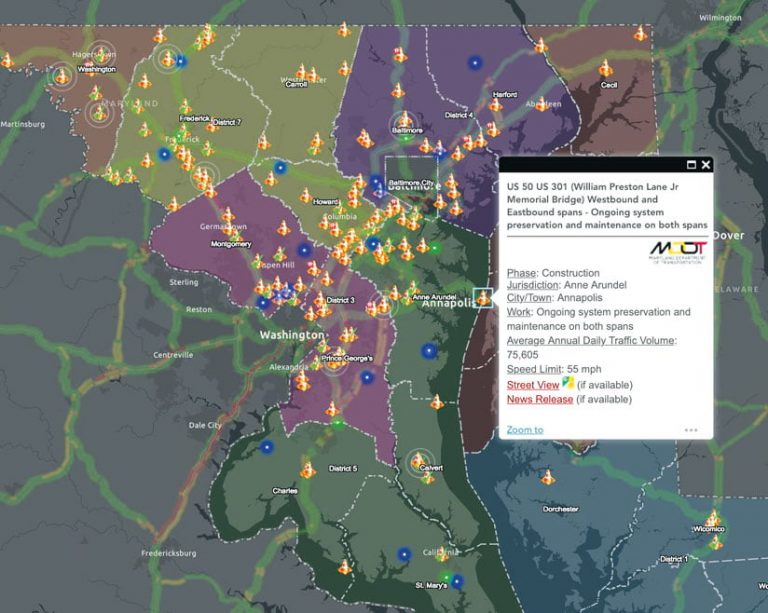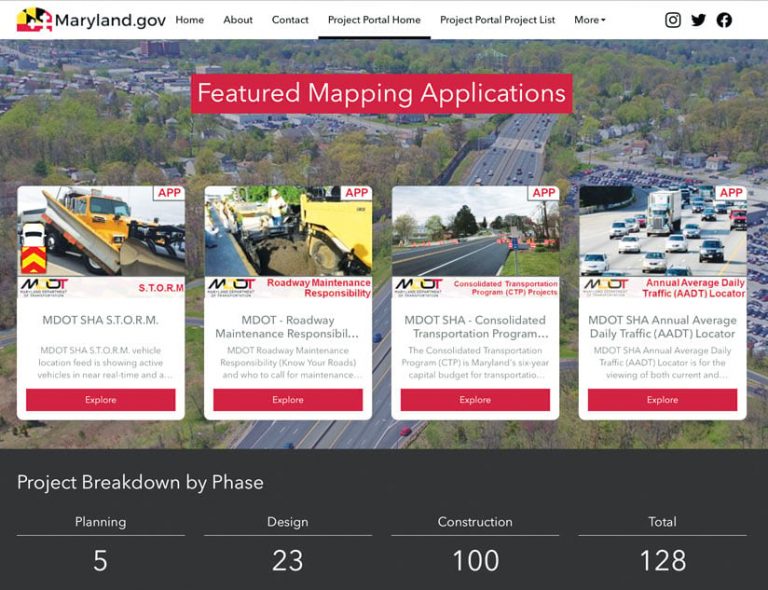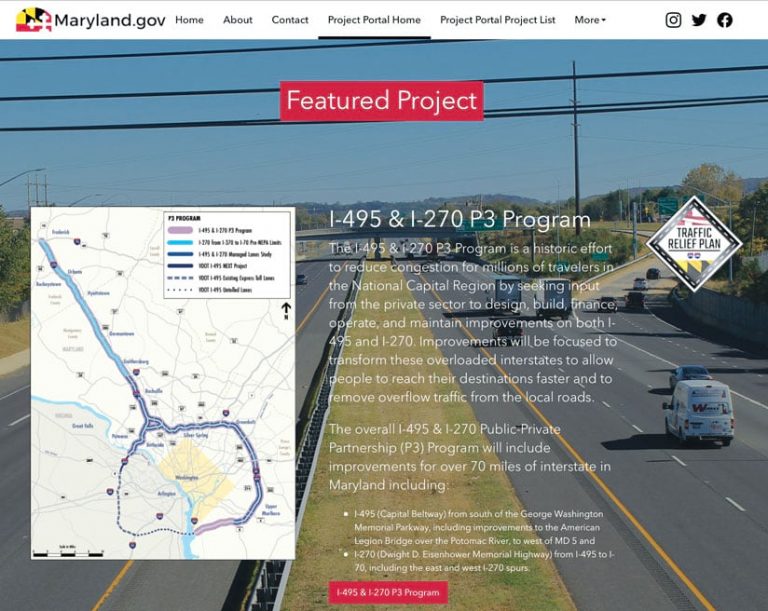Roads are a vital part of a state’s economy and keep people, businesses, and important goods and services moving. As such, adequately maintaining roadways is essential.
The Maryland Department of Transportation (MDOT) is dedicated to roadway maintenance and oversees groups that are responsible for planning, designing, and operating the state’s infrastructure. This includes the State Highway Administration (SHA), which manages operations such as maintenance, construction, and traffic incident response.

Communicating with the public about ongoing projects like bridge replacements, intersection safety improvements, and bicycle and pedestrian enhancements is a priority for MDOT. To give Maryland residents visibility into current and future roadway projects, MDOT SHA created Project Life Cycle, a website that featured details on projects happening throughout the state. While this was an effective form of communication, the initial site needed an overhaul to improve its usability.
Several SHA teams collaborated using ArcGIS Hub to develop a new site, called Project Portal, which officially launched in 2020. The site is more modern and has improved usability, increased traffic, and streamlined back end processes.
“Our new site, created with ArcGIS Hub, allows our team and local officials to more easily communicate what’s going on with roadway projects to our constituents,” said Marshall Stevenson, GIS program manager with MDOT SHA. “We’re doing a much better job of communicating both publicly and internally.”
A User-Friendly Interface
MDOT SHA’s former website was very limited and inflexible. It focused too much on financials and felt more like an internal site than something that would be useful to the public. The site was too difficult to update with new information, and it wasn’t even mobile-friendly.
“Our goal was to have an accurate, easy-to-use website to help educate the public about projects that may impact their travel,” said Shelley Miller, district community liaison (DCL) for MDOT SHA.

The communications team, which led the project, also wanted a new solution that would allow the six DCLs throughout the state, who enter information about projects into the site, to better manage new and existing project pages. These liaisons, like Miller, wanted a system that was easy to use and allowed for more customization.
Ashley Ross, the Office of Communications Project Portal representative for SHA, chose to use Hub to do the website overhaul because she liked its user-friendly interface and how easy it was to incorporate graphics. Stevenson was on board, too, since he wanted a sustainable solution that even non-technical people could maintain.
Since MDOT SHA was already an Esri user, Stevenson just had to do a simple upgrade to begin using the software. From there, the team developed a template for individual project pages, with the goal of creating a sustainable and easily replicable solution.
Staff training was minimal. Ross made several technical guides, a how-to manual, and smaller documents for specific tasks such as uploading images. She also conducted hands-on group sessions for DCLs at MDOT’s regional offices, as well as some virtual trainings to introduce the group to the system and answer questions.
The communications team began creating new project pages for Project Portal in fall 2019, and the final site launched in January 2020. It includes the landing page, a page with a full list of projects, and 100 individual project pages. An events calendar and a map interface shows all projects grouped together according to their MDOT SHA district and individual counties. Each project page contains the latest project updates and relevant SHA contact information. Users can also enter an address into the site and explore projects happening nearby.
“Our Project Portal feature contains lots of information about these projects, including the status, pictures, and videos, and ways to get your questions answered by an expert,” said David Abrams, deputy director for media relations in the SHA Office of Communications. “This feature allows us to keep the public informed.”
Positive Feedback All Around
After being in use for a full construction season in Maryland, Project Portal has received overwhelmingly positive feedback from both staff members and the public.
The use of Hub has improved back end operations at MDOT SHA by streamlining editing and web page creation. It has been easy for nontechnical employees to edit content, update photos and videos, and tailor pages specifically to what each district needs, according to Stevenson.
“Having this system in place that is not dependent on any other system [helps us] change things more easily. Someone can go in there and make an edit and be done,” he said. “This [has] enabled us to add graphics, videos, and maps…that the site really didn’t have before, making it a more user-friendly experience.”

Instead of taking days, like it used to, to add project information to a web page, DCLs can update project information and have it published within an hour. Staff members can even add new details about a project using their phones, tablets, or laptops.
“Working with a project manager,” said Stevenson, “staff can quickly and easily just go in there and make [a] change themselves.”
The templates included with Hub have also improved consistency across pages. And Hub gives MDOT SHA the flexibility it was looking for when it comes to, say, sharing monthly reports.
“Hub allows us to add monthly updates, easy-to-use contact information, and many other important pieces of information for internal and external use while presenting it in a very streamlined, professional, and modern look,” said Miller. “I really love the change using this program made in what we present to the public.”
Stevenson said he has observed increased communication between the DCLs and project managers, thanks to the new portal. He attributes this to DCLs being able to update pages more often and, therefore, engaging in more one-on-one contact with project managers. DCLs are now becoming more knowledgeable about the projects in their areas, he said.
The mobile-friendly site has been a hit with Marylanders, too, which is MDOT SHA’s top priority. In October alone, more than 2,700 users visited Project Portal, 18 percent of whom were returnees to the website. Everyone, including commuters, business owners, and students, seems to enjoy using it.
Ross stressed that getting this information disseminated builds trust between the public and MDOT.
Abrams echoed that sentiment, adding that the hub site makes it simple for customers to locate information about projects in their neighborhoods.
“We have received positive feedback from our customers, our contractors, and also senior managers at MDOT SHA,” Abrams said. “They view the Project Portal as a resource that fits their individual needs to get timely information about our construction projects.”

